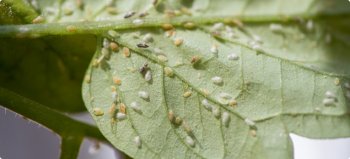
DAFWA said it is undertaking surveillance of the pest, and requests commercial vegetable producers and backyard growers to check for signs of the psyllid and report any unusual detections through the MyPestGuide Reporter app.
The department reported that it has quarantined the impacted properties to restrict the movement of vegetable and plant material off these properties.
This is the first time the psyllid has been detected in Australia. This insect pest is a significant production pest in other countries where it is present, including the USA, Central America and New Zealand.
What is a psyllid?
Tomato potato psyllid (Bactericera cockerelli) is an exotic plant pest which feeds on tomato, potato, capsicum, chilli and solanaceous weeds like nightshade, as well as sweet potato, leading to loss of plant vigour and yield.
The psyllid is a tiny sap-sucking insect. Tomato potato psyllids go through three stages of development – adult, egg and nymph. Adults and nymphs of tomato potato psyllid cause injury to plants by feeding with sucking mouth parts.
- Adult psyllids resemble small winged aphids in appearance about 3mm long. The body is brownish and has white or yellowish markings on the thorax and a broad white band on the abdomen. Wings are transparent and held vertically over the body.
- Nymphs are 2mm long, oval shaped, flattened and scale-like in appearance. Young nymphs are yellowish green to orange with a pair of red eyes and three pairs of short legs. Older nymphs are greenish and fringed with hairs and have visible wing buds.
- Psyllid eggs are less than 1mm long and are attached to the plant by a short vertical thread. They are usually laid on the lower surface of leaves or along the leaf stalk. Eggs are white when first laid then turn yellow to orange after a few hours.
The tomato potato psyllid can carry the bacterium “Candidatus Liberibacter solanacearum”, causing the ‘zebra chip’ disease in potato.
Symptoms of psyllid infestation to look for
Look for damage on the underside of leaves.
Signs of tomato potato psyllid include:
- Insects jumping from the foliage when disturbed.
- Severe wilting of plants caused by high numbers of psyllids feeding.
- Yellowing of leaf margins and upward curling of the leaves caused by the injection of salivary toxins.
- Honeydew which makes the leaves sticky and can cause severe infestations, which can lead to the development of sooty mould.
- Shortening of stem internodes, and
- Stem death are similar to other potato and tomato disorders.
View a short video for more information on what to look for, how to report and provide a sample following good biosecurity practices.
Report the pest
Those who suspect tomato potato psyllid, send a photo to the Department of Agriculture and Food, WA via the MyPestGuide Reporter app available from the Google Play or the App Store or email photos with your name, address and mobile number to [email protected].
Alternatively, call the Pest and Disease Information Service on 1800 084 881.



 Classifieds
Classifieds

